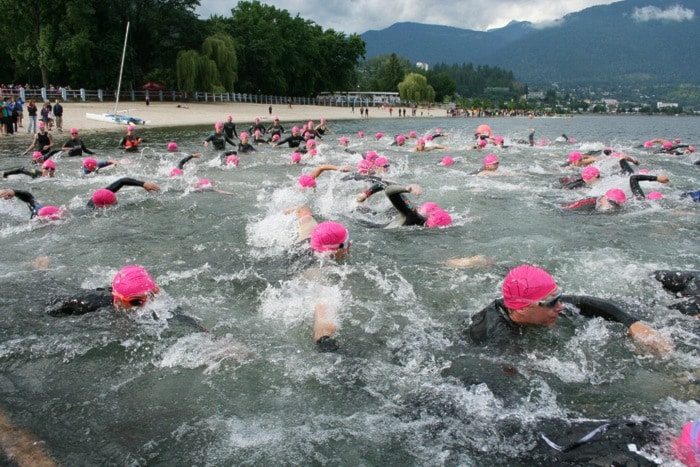For those who have already registered for the triathlon, you are in the thick of training now, getting out there to do your training swims, bikes or runs. Way to go! And for those of you still on the fence, maybe tentatively adding in a few swims or bike rides thinking maybe you’ll do it (but probably not), stop waffling. Go to trinelson.com and register. Do it now.
Let’s talk a little about the event. As I said in the last column, there are two different distances on race day, a sprint distance which is shorter and suitable for anyone convinced that they cannot possibly do this or not sure they’d really want to, and an Olympic distance which (as you’ve probably guessed) is the distance held in the Olympics.
The Olympic distance is about twice the length of the sprint and is great for those who are physically and mentally prepared to go a little longer than the sprint distance.
Swimming, the first leg of triathlon, requires perseverance and overcoming the murkiness of open water swimming. While freestyle swimming (aka front crawl) is the standard stroke used, many people feel more comfortable doing all or part of the swim using breaststroke, backstroke, sidestroke and even the dog paddle. Nothing has been unseen.
At Ironman Canada which has a grueling 3.8 kilometre swim leg, a significant group of breaststrokers were seen working their way around the course. So almost anything goes which gets you from the start to finish; unfortunately that doesn’t include flippers, pull buoys or aids of any sort.
Going to a swimming pool and practicing one or a combination of strokes is a great way to get ready. As the weather warms, getting into the lake helps to get used to the temperature and the lack of lines on the bottom to direct you.
For those of us who have not grown up swimming (I started at 40; I know two women who started swimming and triathlon around age 60), the swim is mostly a matter of survival before we enter the more fun portions of the triathlon — the bike and the run.
The bike portion of Cyswog n’ Fun is mostly flat. Phew. Getting ready for the bike, like the swim, means getting out there and putting in some miles. Build the miles bit by bit. A common rule for increasing mileage is 10 per cent per week. For example, if you biked 20 km total last week, then this week 22 should be about the total. This helps your body adapt to the distance you want to go by putting the body under stress.
It’s natural to feel tired and maybe even a little (but just a little) sore. The formula for increasing the body’s ability to handle greater distances is to increase stress on the body (by increasing mileage), and rest. Rest is a critical element to building fitness. It is during rest that the body actually adapts to our request to be stronger and fitter. So be sure that with the mileage you are doing in any of the three sports that you are also getting plenty of rest.
The run. Once you’ve made it this far in the triathlon, it’s about putting one foot in front of the other. So much simpler, really, than swimming (you can see where you’re running and breathing oxygen is very nice) or biking (running shoes can’t get a flat). Unfortunately, it’s also the hardest of the three on your body.
More than the other two events, pay attention to not increasing your mileage too quickly. Adhere to the 10 per cent rule. If you are new to running or returning after a long lay-off, consider a walk-run program of three minutes running and two minutes walking, or 4 and 1, or even 9 and 1. It’s much easier on the body and the mind than trying to grind through a run that isn’t feeling good.
However you approach the run or walk-run, being able to carry on a conversation is a good speed to go at to increase aerobic endurance. Aerobic endurance will get you through the triathlon to the finish area where there are massages, food and, best of all, family and friends in a state of stupefaction than you that you actually did it. Now tell me, what could be more satisfying than that?
Until next time, happy training. Increase your distance incrementally, rest, and above all, listen to what your body is telling you. Keep up the great work.
